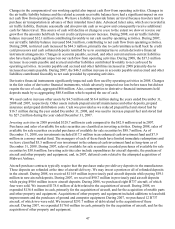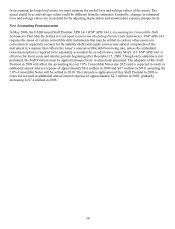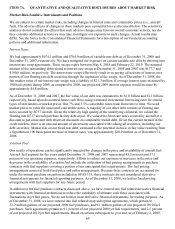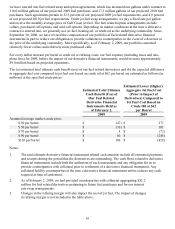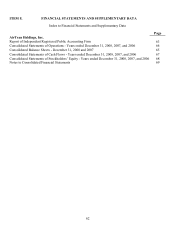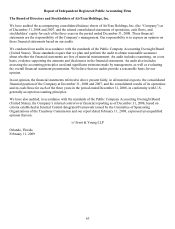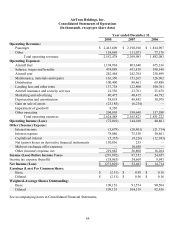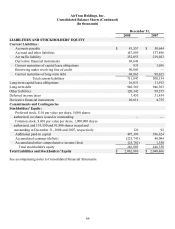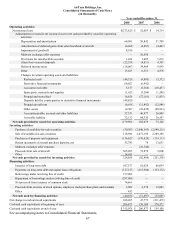Airtran 2008 Annual Report Download - page 65
Download and view the complete annual report
Please find page 65 of the 2008 Airtran annual report below. You can navigate through the pages in the report by either clicking on the pages listed below, or by using the keyword search tool below to find specific information within the annual report.Frequent Flyer Program. We accrue a liability for the estimated incremental cost of providing free travel for
awards earned under our A+ Rewards Program based on credits we expect to be redeemed on us or the
contractual rate of expected redemption on other carriers. Incremental cost includes the cost of fuel, catering,
and miscellaneous direct costs, but does not include any costs for aircraft ownership, maintenance, labor or
overhead allocation. We adjust this liability based on credits earned and redeemed, changes in the estimated
incremental costs, and changes in the A+ Rewards Program.
We also sell credits in our A+ Rewards Program to third parties, such as credit card companies, financial
institutions, car rental agencies, and florists. Revenue from the sale of credits is deferred and recognized as
passenger revenue when transportation is expected to be provided, based on estimates of its fair value. The
remaining portion, which is the excess of the total sales proceeds over the estimated fair value of the
transportation to be provided, is recognized in other revenue at the time of sale. A change to the time period
over which the credits are used (currently one to two years), the actual redemption activity or our estimate of the
amount or fair value of expected transportation could have a significant impact on our revenue in the year of
change as well as future years.
Accounting for Derivative Financial Instruments. We enter into various commodity derivative financial
instruments with financial institutions to reduce the variability of ultimate cash flows associated with
fluctuations in jet fuel prices. We enter into both fuel swap and option arrangements. We also enter into interest
rate swap agreements that effectively convert a portion of our floating-rate debt to a fixed-rate basis thus
reducing the impact of interest-rate changes on future interest expense and cash flows. See ITEM 7A.
“QUANTITATIVE AND QUALITATIVE DISCLOSURES ABOUT MARKET RISK” and ITEM 8.
“FINANCIAL STATEMENTS AND SUPPLEMENTARY DATA, Note 4 – Financial Instruments” for
additional information about the derivative instruments that we have executed.
Statement of Financial Accounting Standards No. 133 (SFAS 133), Accounting for Derivative Instruments and
Hedging Activities , requires a company to recognize all of its derivative instruments as either assets or
liabilities in the statement of financial position at fair value. The accounting for changes in the fair value (i.e.,
unrealized gains or losses) of a derivative instrument depends on whether it has been designated and qualifies as
part of a hedging relationship and further, on the type of hedging relationship. For those derivative instruments
that are designated and qualify as hedges for accounting purposes, a company must designate the hedging
instrument, based upon the exposure being hedged, as a fair value hedge, cash flow hedge or a hedge of a net
investment in a foreign operation. For derivative instruments that are designated and qualify as a cash flow
hedge (i.e., hedging the exposure to variability in expected future cash flows that is attributable to a particular
risk), the effective portion of the gain or loss on the derivative instrument is reported as a component of other
comprehensive income and reclassified into earnings in the same line item associated with the forecasted
transaction in the same period or periods during which the hedged transaction affects earnings (for example, in
“interest expense” when the hedged transactions are interest cash flows associated with floating-rate debt). For
derivative instruments that are not designated as hedges for accounting purposes or do not qualify as hedges for
accounting purposes, changes in the unrealized fair value of the derivatives are reflected in other (income)
expense each period.
SFAS 133 is a very complex accounting standard with stringent requirements which generally requires:
documenting the hedging strategy; using statistical analysis to qualify certain derivative arrangements as a
hedge for accounting purposes both on a historical and a prospective basis; and preparing strict
contemporaneous documentation that is required at the time each accounting hedge is designated by us. As
required by SFAS 133, we assess the effectiveness of each of our individual hedges on a quarterly basis. This
analysis involves utilizing regression and other statistical analyses intended to assess the effectiveness of each
derivative designated as a hedge for accounting purposes. Certain derivatives may not qualify for treatment as
accounting hedges if there is an insufficient correlation between the hedged item and the derivative underlying
price. For example, derivatives based on crude oil as the underlying price did not qualify for hedge accounting
treatment as of December 31, 2008.
57


